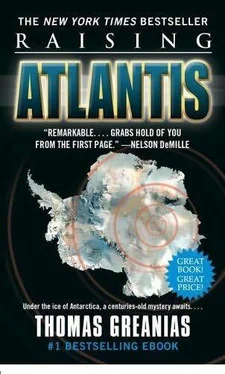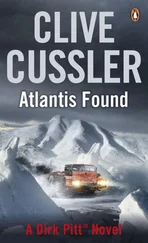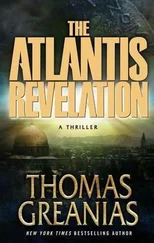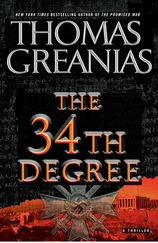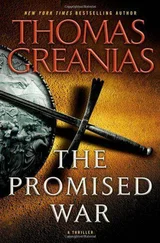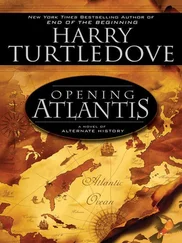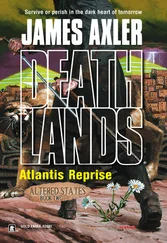Yeats said, “But none of these were anything like the high-tech civilization Plato insisted was destroyed almost twelve thousand years ago.”
“True.”
“So this could be Atlantis.”
“It could be.” Conrad shrugged. “Look, all I’m saying is that if you throw a dart at a world map you’ll find somebody’s idea of Atlantis,” Conrad said. “Or, if you’re like my show’s producer, you could throw darts at solar systems on celestial charts. The possibilities are infinite. I can’t draw any conclusions until I get inside P4.”
“I can’t promise you’ll get inside, son,” Yeats said. “Not yet. This is a military operation. So if you’ve got a theory about P4, put up or shut up.”
“Fine. Then I’ll take my frequent flier miles and go home.”
“Goddamn it, Conrad.” Yeats smashed his fist into the tabletop. “You’re not going anywhere. And if you want to get inside P4, you better tell me something I don’t already know.”
Conrad stood up and walked over to the window. For a wild moment Yeats worried that Conrad would pick up a metal chair and try to shatter the reinforced glass. But he simply stared outside as the wind howled. The man had learned to master the rage that had consumed him as a boy.
“OK then,” Conrad finally said without turning around. “My best guess is that P4 may well be the original on which the Great Pyramid in Giza was modeled, except on a much grander scale. In other words, P4 is the real deal and the Great Pyramid that Khufu built is an inferior clay replica.”
“Your best guess?” Yeats repeated. “I can’t work off hunches, son.”
“It’s more than that,” Conrad said. “Your own data says the base is aligned at the cardinal points-north, south, east, and west. It’s also sloped at an angle of fifty-one degrees, fifty-two minutes-just like the Great Pyramid. And knowing what I do about the Great Pyramid, up close and personal, I can make some educated guesses about P4.”
Yeats exhaled. “Like what?”
“Like the probability that P4 is a representation of the Southern Hemisphere of Earth.”
“Whereas the Great Pyramid in Egypt is a representation of the Northern Hemisphere of Earth,” Yeats said. “I get it. So what?”
Conrad crossed the floor to the desk and tapped a few keys on his laptop. “The hemisphere is projected on flat surfaces as is done in map making.” He turned his laptop around so Yeats could see the graphic on his screen. It looked like a German cross. “This is the pyramid if we flattened it out. The apex represents the South Pole, and the perimeter represents the equator.”
“Go on.”
“This is the reason why the perimeter is in relation two pi to the height,” Conrad explained. “P4 thus represents the Southern Hemisphere on a scale of one to forty-three thousand two hundred.”
“Represents the Southern Hemisphere in relationship to what?” Yeats asked.
“The heavens,” said Conrad. “The ancients associated certain meanings with various constellations. Once I determine this pyramid’s celestial counterpart in the skies we’ll have a better idea of its function.”
“Function?” Yeats repeated. “It’s a tomb, right?”
“Pyramids themselves were never designed to serve as burial places, although they were used that way in some cases,” Conrad said. “Their higher purpose was connected to the ancient king’s quest for eternal life. To attain it he would have to participate in the discovery of a revelation that would unveil the mystery of ‘First Time.’ ”
“First Time?” Yeats stared hard at him. “What’s that?”
“It’s the secret of Creation,” Conrad said. “How the universe was formed, how we got here, where we’re going.”
“Where we’re going? Now how the hell would the builders of P4 know that?”
“The ancients believed that the cosmic calendar resets itself every twenty-six thousand years or so,” Conrad said. “Each epoch of time ends in some cataclysm leading to a new creation or age. Survivors of such global extinction events would naturally want to warn future generations.”
“So this secret goes all the way back to Genesis?”
“Earlier than that,” Conrad said. “According to Aztec and Mayan myths, there have been at least five Suns or Creations. This is allegedly the Fifth Sun we’re living in.”
“What happened to the Fourth Sun?” Yeats demanded.
“Well, according to the ancients, it was destroyed by the Great Flood,” Conrad said. “Based on the four rings we found on the benben stone, my guess is that P4 was built at the very dawn of the Fourth Sun, just after the destruction of the Third Sun, right around the time the biblical story of Genesis says God created the heavens and the earth.”
“You just told me P4 goes further back than that.”
“That’s because inside the pyramid I expect to find a repository of knowledge from the previous three Suns,” Conrad said. “It might even contain the secret of First Time itself, something older than the known universe.”
Yeats started pacing back and forth, unable to contain his excitement. His bum leg was killing him, but he didn’t care. “You sure about all this?”
“Won’t be until I get inside.” Conrad’s face darkened. “But it’s fair to assume that, whatever else is down there, P4 holds a legacy of knowledge at least as great as our own.”
“Which is why we have to get inside first,” Yeats concluded. “Because it won’t be long before we have company.”
Conrad asked, “You find the entrance yet?”
“I’ve got a drill crew working out of a rig we’ve set up on P4’s summit,” Yeats said. “The top of the pyramid, about fifty feet of it, sticks out of the bottom of the abyss like the tip of an iceberg. The crew has been drilling a hole down the east face toward the base. That’s where the computer models say we’ll find the entrance. We’re about halfway there.”
Conrad said, “You’re drilling in the wrong place.”
Yeats took a deep breath. “OK, then. Where should I be drilling?”
“The north or south face, although with P4 I’d favor the north face,” Conrad said. “Less than a half mile down the drill crew will most likely find the entrance to a large shaft that will take us into the heart of P4.”
“Most likely?” Yeats huffed. “You want me to pull my team off mission just to follow your instinct?”
“Look, if P4 is indeed the original on which the Great Pyramid was modeled, then I suspect we’ll find two shafts radiating from the center of the pyramid out the south and north faces of the exterior. If the similarities I’m seeing continue to play out, then we can use these shafts to get inside P4 in half the time it’s going to take you right now.”
“And what exactly is the function of these shafts? If they exist.”
“I have an idea,” Conrad said. “But I’d have to get inside P4 to be certain.”
“Naturally,” Yeats grumbled.
“I thought the price of admission to P4 was to tell you something you didn’t already know,” said Conrad when the intercom buzzed. “I just did.”
“What you told me means nothing if we can’t find this shaft you allege exists,” Yeats said.
“You will,” Conrad insisted when the com beeped again.
Irritated, Yeats flicked on his screen. It was O’Dell in the command center. “What is it?”
“One of our long-range patrols just reported in,” O’Dell said. “Looks like Doctor Yeats’s little distress call attracted some attention. We’ve got company.”
Discovery Plus Twenty-Four Days, Sixteen Hours
The air lock door slid open and a blast of polar air blew in with a flurry of snow. An ethereal figure emerged from the cloud in a green Gore-Tex parka. And even before the fur-lined hood dropped and the ultraviolet glasses came off, Conrad instinctively knew who it was.
Читать дальше
